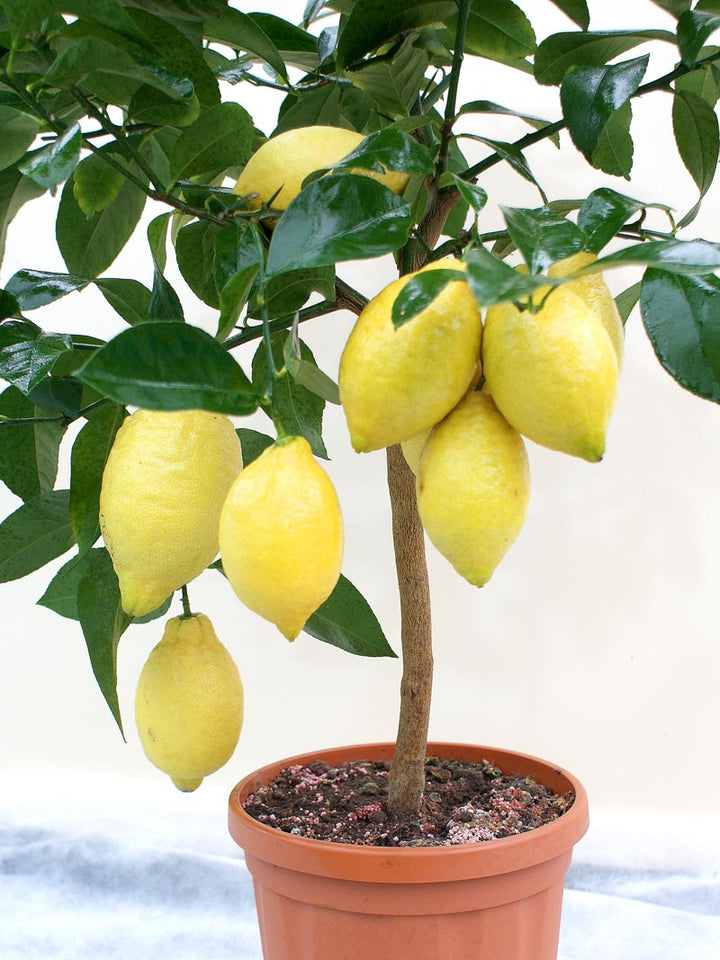- No products in the basket
Citrus Care Guide - Caring for Citrus Tree Topiary
How to Care for Citrus Topiary
Quick Navigation

We would like your citrus tree to be happy and healthy and last for years to come.
On this page you will find our care advice specifically for lemons, oranges, limes and other citrus that will let you know what your plant needs.
We have also included our recommended products, products that we use ourselves, that will help you keep your plant looking at its very best.
RECOMMENDED PRODUCTS FOR CITRUS CARE
Citrus Care Instructions
General Care
Citrus are Mediterranean plants and to understand their requirements it is useful to think of the conditions they are accustomed to in that environment. They have hot dry summers and a year long exposure to high light levels, well drained soils and rain that falls mainly in winter.
Growing citrus in this country can be very satisfactory especially if you take care of the growing conditions.
Citrus prefer to be outside in the summer months where the light levels and air circulation is beneficial to the health of the plants. Make sure they are protected from damaging cold winds. In this country they are best suited to container growing.
Winter Care
All citrus must be protected from the winter cold in this country. All citrus prefer a cool winter rest period. Lemons require a minimum winter temperature of 10 degrees centigrade and Calamondin Oranges require 13 degrees centigrade whilst others can withstand 7 degrees centigrade. Citrus require high light levels so it is sensible to locate them close to a window, preferably in a cool greenhouse or conservatory. However try and ensure that the temperature levels do not fluctuate too much as low temperatures can cause failure to flower or loss of leaves. Take care not to overwater in winter, water only when the top layer of compost has dried out, you are more likely to overwater rather than underwater during winter. In winter it is necessary to continue feeding your citrus plant but change to a balanced fertilizer, this helps prevent leaf drop and contributes to the general health of the plant during winter but does not encourage excessive growth. You can keep the air around your plant moist by putting gravel in the saucer underneath the pot and keeping this damp, do not let this water come above the level of the gravel as it may come into contact with the roots and cause them to rot. This moist gravel will also aid the blossom to set fruit
Recommended Products: Winter Citrus Feed
Pruning
The main reason for pruning citrus trees is to maintain their shape and size and to increase the air flow within the tree. There are 2 types of pruning for citrus plants. Firstly any misplaced shoots or branches can be removed in February. At this time you can also shorten any branches necessary to keep the tree bushy. Secondly, during summer pinch out the ends of any vigorous shoots that are going to grow too tall for the shape of the tree.
If there is a lot of young fruit you will probably find that the tree will shed a certain percentage of this which is normal as the tree is protecting itself from overbearing.
Watering
 Yelow leaves on citrus. Credit: RHS/The Garden
Yelow leaves on citrus. Credit: RHS/The GardenAlthough citrus enjoy a humid atmosphere, it is important to avoid overwatering. Water freely in a hot summer, ensuring the pot is not standing in water and during winter only apply water when the surface of the compost has dried out. Too much watering in winter can cause yellowing of leaves or loss of leaves. Yellowing of leaves can also be a symptom of dry roots so check the soil before you take action.
Feeding
Citrus are heavy feeders. Use a fertilizer with a high nitrogen content from spring to late October when you can change to a balanced fertilizer for the winter. Continue to feed during winter. Try to apply fertilizers on a regular basis.
Recommended Products: Summer Citrus Feed, Winter Citrus Feed
Potting On
The best time to pot on citrus is during early spring. When potting on citrus us a loam based compost such as John Innes No 2, preferably using the ericaceous variety if you have a hard water supply as citrus prefer a slightly acid growing medium. Additional grit added to the mix helps the drainage. Special citrus composts are also available. Only pot on to one size larger at a time.
Temperature
Temperature control is important for citrus. Too much heat or excessive cold can cause the leaves to drop. Fluctuations in temperature are most damaging. However, no citrus will tolerate prolonged cold weather. Keep within the minimum temperatures. Hot and dry conditions can cause the leaves to become scorched, using gravel in a saucer under the pot helps to avoid this very drying atmosphere.
Citrus Pests
Red Spider Mite
 Red spider mites on webbing. Credit: RHS
Red spider mites on webbing. Credit: RHSWhat are they?
Red spider mites are a small group of aracnids that belong to the Acari. They are a common pest on houseplants and both ornamental and edible greenhouse plants. Adults measure about 0.5mm in length and despite their name some species are not all red, some are green, yellow or orange. They have a habit of spinning a loose silk webbing on infested plants so can be mistaken for small spiders. Heavy infestation of red spider mite can result in complete defoliation.
Symptoms
Leaves show a fine pale mottling on the upper surface while the underside may have small yellowy green mites. The appearance of a fine silk webbing in a heavy infestation will result in foliage losing colour, drying up and falling off.
Control
Red spider mites can be difficult to control as warm conditions can become a breeding ground. If caught early spraying the foliage with a warm soapy washing up liquid solution can keep them under control, particularly on those plants that can be placed outside during the summer months. Biological control predators can be introduced such as the predatory mite Phytoseiulus similis which have been found to be the most effective. These feed on all life stages of the red spider mite and will disperse and die if all are eaten, they will not become pests themselves. A non organic solution is a plant invigorator such as SB Plant Invigorator. This has a short persistence so reapplication is required to keep their number to a minimum. Plant invigorators should not be used in addition to predatory mites.
Scale Insects
 Scale Insects. Credit: RHS Horticultural Science
Scale Insects. Credit: RHS Horticultural ScienceWhat are they?
Scale insects are sap sucking insects that suck the sap from a wide variety of plants. In the UK there are over 25 species ranging from 1mm to 1cm in diameter. During their growing phase they are fairly mobile, once they reach maturity and grow their hard shell, they become sedentary fixing themselves to one spot and feeding on the sap on the host plant.
Symptoms
If you have an infestation the damage will be clearly seen on plants, leaves will turn mottled and yellow before dropping off. Other symptoms include, scales or bumps on leaves and plant stems, these are the scale insect covering; small white, waxy clusters protecting scale insect eggs and found in the early summer; a sticky substance known as honeydew on the upper surfaces of leaves. Heavy infestations may result in poor growth and plant health.
Treatment
If infestations are small, they can be removed by hand by picking them off or by gently wiping the insects with a cloth soaked in alcohol or neem based product. Pruning and disposing of infected stems or branches can solve the problem if caught early enough.
If the problem is on outdoor plants, introducing natural predators such as ladybirds, parasitoid wasps or birds will prey on and eat scale insects and their young larvae.
Organic sprays, fatty acids, and plant oils can give good control but will require reapplication as they have a short persistence. Additionally these products are unlikely to affect larger insects and predators such as ladybirds.
Other more persistent contact action insecticides and systemic neonicotinoid insecticides are available but must be used with caution on and around edible plants.
Mealybugs
 Mealybugs. Credit: RHS Horticultural Science
Mealybugs. Credit: RHS Horticultural ScienceWhat are they?
Similar to scale insects mealybugs are a common sap feeding insect that secretes a sticky honeydew substance and found on many houseplants and greenhouse plants. The citrus mealybug are small soft bodied insects, white in colour with a central grey stripe, short tail filaments and generally covered in a white waxy material. They are often found in clusters on stems and leaf whorls.
Symptoms
The first signs of mealybug are a fluffy white wax in the sheltered areas of the plant. An accumulation of secreted honeydew makes the plants sticky which leads to a sooty mould growth resulting in a blackened appearance on leaves and stems. This in turn can weaken the plant resulting in the discolouring of leaves and defoliation.
Control
Biological control predators such as the ladybird Cryptolaemus and parasitic wasp Leptomastix can be used to reduce and rid plants of mealybugs.
Cryptolaemus is a black/brown ladybird with an orange head and tail and around 4mm in length. Its larvae are white and look like large mealybugs, once hatched they are voracious predators of mealybugs. They are strong fliers and most effective in the summer where they require a temperature of at least 20ºC (68ºF) and good levels of sunlight if required to fly to new plants.
Leptomastix are tiny yellow to black wasps and work best if used alongside Cryptolaemus. They lay their eggs in nearly fully grown mealybugs, which then become swollen and brown in colour and finally mummified. The adult Leptomastix then emerge from the mummy, the life cycle taking around 2-4 weeks depending on the temperature.
Both Cryptolaemus and Leptomastix need warm temperatures and so will be more successful during the summer months. They are living creatures and will be affected by chemicals and pesticide, they should be used as an alternative rather than an addition.
RECOMMENDED PRODUCTS FOR CITRUS CARE
Further Reading
The RHS website has further information of pests and diseases that can affect citrus trees: https://www.rhs.org.uk/advice/profile?pid=355


